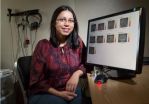(Press-News.org) Genomic sequencing is supposed to reveal the entire genetic makeup of an organism. For infectious disease specialists, the technology can be used to analyze a disease-causing bacterium to determine how much harm it is capable of causing and whether or not it will be resistant to antibiotics. But new research at Rockefeller University suggests that current sequencing protocols overlook crucial bits of information: isolated pieces of DNA floating outside the bacterial chromosome, the core of a cell's genetic material.
"Extensive sequencing of chromosomal DNA has been performed for a variety of pathogenic organisms, but these sequences fail to uncover the presence of DNA elements in the cell's cytoplasm. As a result, the DNA profile of a pathogenic bacteria may be incomplete," says Vincent Fischetti, head of the Laboratory of Bacterial Pathogenesis and Immunology. "We have now devised a way to identify these elements."
Extrachromosomal DNA can include bacteria-infecting viruses, known as phages, and strands of self-replicating DNA, known as plasmids, often picked up from other bacteria. These phages and plasmids can easily move between bacterial cells, and scientists have known for some time that, as a result, these so-called mobile genetic elements can play important roles in virulence and antibiotic resistance.
This study focused on phages. Their activity outside the chromosomes has been poorly studied; most research has focused on phages integrated into bacterial chromosomes. Meanwhile, plasmids, which allow bacteria to share genes among themselves, are well studied.
"So far, no one has looked across a variety of strains of bacteria, as we have done with Staphylococcus aureus, to find these extrachromosomal phages that have potential to play an important role in disease," says Bryan Utter a postdoc in the lab and the first author of the research published June 25 in PLoS ONE. Staphylococcus is a common bacterium that can cause serious or even fatal infections under certain circumstances.
Until now, an analysis of this scope wasn't possible, because chromosomal DNA easily fragments and contaminates the sample during the process by which researchers prepare the extrachromosomal DNA, making them virtually impossible to identify and sequence.
"To solve this problem, we borrowed a tool from phages themselves: the enzymes these viruses use to break apart a phage-infected cell to release their progeny," says Douglas Deutsch, a graduate student in the lab. These enzymes, a focus of research in the lab in the development of novel anti-infectives, are now being harnessed to gently extract the chromosomal DNA, while leaving behind any other genetic elements for analysis. Using this technique, they looked for extrachromosomal phages across 24 medically important strains of Staphylococci.
Not only did extrachromosomal phages appear widespread among these strains, but the researchers found evidence that these phages encode genes that can make the bacteria more dangerous.
For example, when the researchers decoded the complete sequence of one extrachromosomal circular phage from a disease-causing Staphylococcus, they identified a number of genes that may help this strain evade a host's immune system and that could readily spread to other Staphylococcus bacteria. The researchers are now studying what role, if any, these viral genes play in this strain's ability to cause disease.
The implications go beyond pathogenicity. Phage elements, including those not integrated into chromosomes, are part of a bacterial system for regulating genes. For instance, some of these phage elements can activate or silence bacterial genes by moving into or out of the chromosome. Within the Staphylococcus strains, the researchers found both transient elements as well as those residing permanently outside the chromosomes.
"By examining the DNA outside the bacterial chromosomes, you may get a better understanding of the dynamics by which these elements may mobilize thereby controlling microbial genes," Fischetti says.
INFORMATION:
Sequencing efforts miss DNA crucial to bacteria's disease causing power
2014-06-26
ELSE PRESS RELEASES FROM THIS DATE:
A win-win-win solution for biofuel, climate, and biodiversity
2014-06-25
Fossil fuel emissions release billions of tons of carbon into the atmosphere each year, which is changing the climate and threatening the sustainability of life on planet Earth. In Brazil, the demand for alternative energy sources has led to an increase in biofuel crops. A new "News and Views" paper in Nature Climate Change, co-authored by Woods Hole Research Center scientists Marcia Macedo and Eric Davidson, reviews new research conducted by Brazilian colleagues demonstrating the high carbon costs of converting intact Brazilian savanna compared to the carbon gains obtained ...
Scientists develop a 'nanosubmarine' that delivers complementary molecules inside cells
2014-06-25
VIDEO:
Francisco Raymo discusses his work in this video.
Click here for more information.
CORAL GABLES, Fla. (June 25, 2014) — With the continuing need for very small devices in therapeutic applications, there is a growing demand for the development of nanoparticles that can transport and deliver drugs to target cells in the human body.
Recently, researchers created nanoparticles that under the right conditions, self-assemble – trapping complementary guest molecules within ...
NASA's STEREO maps much larger solar atmosphere than previously observed
2014-06-25
Surrounding the sun is a vast atmosphere of solar particles, through which magnetic fields swarm, solar flares erupt, and gigantic columns of material rise, fall and jostle each other around. Now, using NASA's Solar Terrestrial Relations Observatory, scientists have found that this atmosphere, called the corona, is even larger than thought, extending out some 5 million miles above the sun's surface -- the equivalent of 12 solar radii. This information has implications for NASA's upcoming Solar Probe Plus mission, due to launch in 2018 and go closer to the sun than any man-made ...
New NASA model gives glimpse into the invisible world of electric asteroids
2014-06-25
Space may appear empty -- a soundless vacuum, but it's not an absolute void. It flows with electric activity that is not visible to our eyes. NASA is developing plans to send humans to an asteroid, and wants to know more about the electrical environment explorers will encounter there.
A solar wind blown from the surface of the sun at about a million miles per hour flows around all solar system objects, forming swirling eddies and vortices in its wake. Magnetic fields carried by the solar wind warp, twist, and snap as they slam into the magnetic fields around other objects ...
Carbon-fiber epoxy honeycombs mimic the material performance of balsa wood
2014-06-25
Cambridge, Mass. – June 25, 2014 – In wind farms across North America and Europe, sleek turbines equipped with state-of-the-art technology convert wind energy into electric power. But tucked inside the blades of these feats of modern engineering is a decidedly low-tech core material: balsa wood.
Like other manufactured products that use sandwich panel construction to achieve a combination of light weight and strength, turbine blades contain carefully arrayed strips of balsa wood from Ecuador, which provides 95 percent of the world's supply.
For centuries, the fast-growing ...
Changes in forage fish abundance alter Atlantic cod distribution, affect fishery success
2014-06-25
A shift in the prey available to Atlantic cod in the Gulf of Maine that began nearly a decade ago contributed to the controversy that surrounded the 2011 assessment for this stock. A recent study of how this occurred may help fishery managers, scientists, and the industry understand and resolve apparent conflicts between assessment results and the experiences of the fishing industry.
When the dominant prey species of Atlantic cod changed from Atlantic herring to sand lance beginning in 2006, cod began to concentrate in a small area on Stellwagen Bank where they were easily ...
New insights for coping with personality changes in acquired brain injury
2014-06-25
Amsterdam, NL, June 25, 2014 – Individuals with brain injury and their families often struggle to accept the associated personality changes. The behavior of individuals with acquired brain injury (ABI) is typically associated with problems such as aggression, agitation, non-compliance, and depression. Treatment goals often focus on changing the individual's behavior, frequently using consequence-based procedures or medication. In the current issue of NeuroRehabilitation leading researchers challenge this approach and recommend moving emphasis from dysfunction to competence. ...
People with tinnitus process emotions differently from their peers, researchers report
2014-06-25
CHAMPAIGN, Ill. — Patients with persistent ringing in the ears – a condition known as tinnitus – process emotions differently in the brain from those with normal hearing, researchers report in the journal Brain Research.
Tinnitus afflicts 50 million people in the United States, according to the American Tinnitus Association, and causes those with the condition to hear noises that aren't really there. These phantom sounds are not speech, but rather whooshing noises, train whistles, cricket noises or whines. Their severity often varies day to day.
University of Illinois ...
New math technique improves atomic property predictions to historic accuracy
2014-06-25
By combining advanced mathematics with high-performance computing, scientists at the National Institute of Standards and Technology (NIST) and Indiana University (IU) have developed a tool that allowed them to calculate a fundamental property of most atoms on the periodic table to historic accuracy—reducing error by a factor of a thousand in many cases. The technique also could be used to determine a host of other atomic properties important in fields like nuclear medicine and astrophysics.*
NIST's James Sims and IU's Stanley Hagstrom have calculated the base energy levels ...
Study: Motivational interviewing helps reduce home secondhand smoke exposure
2014-06-25
A Johns Hopkins-led research team has found that motivational interviewing, along with standard education and awareness programs, significantly reduced secondhand smoke exposure among children living in those households.
Motivational interviewing, a counseling strategy that gained popularity in the treatment of alcoholics, uses a patient-centered counseling approach to help motivate people to change behaviors. Experts say it stands in contrast to externally driven tactics, instead favoring to work with patients by acknowledging how difficult change is and by helping people ...




